Apple iPod nano

Introduction
After many years of giving myself reasons to avoid buying an iPod, I finally gave in after seeing the announcement of the iPod nano. Why? First of all, for the longest time, I was critical of the Apple iPod due to its poor battery life (compared to what I’m used to) and Apple’s policy of replacing batteries and the need to purchase an additional warranty. Secondly, I already owned a pretty nice hard disk-based MP3 player and found that my listening habits did not require me needing to have all or a very large portion of my music with me at all times. Thirdly, flash-based MP3 players are more appealing to me since they tend to last longer (battery life) and are more durable since there’s no moving parts. The lower capacity is fine due to reason number two. Finally, the design of the iPod nano was the first that simply made me want to get one.
So, I quickly purchased a white iPod nano (4GB) a few days after the launch and have been using it for almost a month now and have some impressions about it. Why no black? I did think about the black one since it looked pretty nice but you’ll find out why I’m glad I didn’t later on in this review.
Apple iPod nano
The iPod nano is Apple’s latest evolution of the iPod with a size in between the iPod shuffle and the iPod mini. The new slim design basically makes it look like a cross between a full sized iPod and the iPod shuffle. The Apple iPod nano essentially kills off the iPod mini while offering a similar capacity 4GB and a new smaller capacity at 2GB. It’s also Apple’s first flash-based MP3 player that has a screen and it’s a color one at that.

The specifications for the model I purchased are the following:
Apple iPod nano 4GB
- 4GB Model (Approximately 1000 songs)
- 14 hour battery life (4 hours slideshow / music)
- 1.5†color LCD screen with LED backlight
- USB dock connector
- 1/8†Stereo mini-jack output
- 3 hours charge time (1.5 hours to 80% fast charge)
- AAC (16 to 320 Kbps), Protected AAC (from iTunes Music Store), MP3 (16 to 320 Kbps), MP3 VBR, Audible (formats 2, 3 and 4), Apple Lossless, WAV, AIFF
- Size: 3.5†x 1.6†x 0.27â€
- Weight 1.5 oz.
- Included accessories: Earbud headphones, USB cable, Dock adapter

As you can see, it doesn’t come with much other than the ear-buds and the USB cable. It would have been nice for them to include the Dock considering the price but Apple wants to sell you a bunch of accessories so it makes sense. It really would have been nice for them to include some sort of protective covering even if it’s some sort of slip case but again, it’s all about accessories and there’s sure to be plenty for this or any other iPod product.
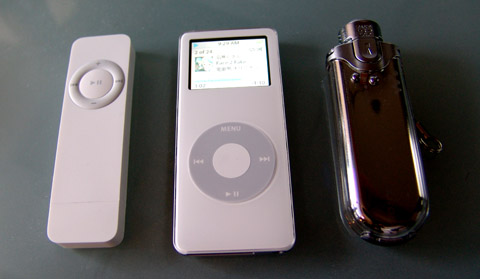
For size comparisons, here’s a shot of the iPod nano next to the iPod shuffle and Sony’s Network Walkman NW-E507.
Build Quality
It really is hard to fathom how thin and beautiful the iPod nano is until you crack open the box. As always, Apple’s packaging is thoughtful and laid out with a touch of class that you don’t often find. I prefer items that come in boxes since I hate blister packaging.
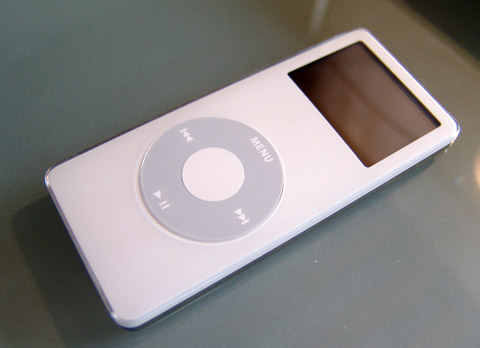
Taking the iPod nano out and removing the protective film reveals a gorgeous device that is remarkably thin and light. The design itself is simple and unassuming with just the connector, the headphone jack, and the hold switch. There’s literally no room for any other buttons, connectors or switches. Because the slim design of the iPod nano, the headphone jack must be located on the bottom of the device. The face of iPod nano has the ever present scroll wheel to go along with Apple’s well known interface.
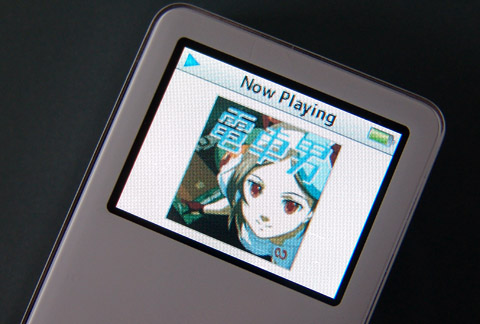
The LCD screen is very readable and the LED backlight is very bright and uniformly lit. In bright ambient light, the screen is still easy to read and well implemented. The color is decent although a little washed out. The resolution is good enough for text to be readable and CD covers look pretty next to the song titles. They are pretty small though unless you scroll through the viewing modes during playback to see a larger thumbnail.

There’s a hold switch on the top of the device that keeps the scroll wheel locked and keeps the unit from being accidentally turned on. When locked, the hold switch shows a red indicator so you can tell at a glance that it’s in hold mode.
The body itself is a mix of polycarbonate and shiny metal not unlike the previous iPod models. However, the polycarbonate shell part is thinner and flatter than previous models with a flatter front that has less beveled on the edges. It’s a more modern design and even the newly announced 5th generation iPods use this new look. The polycarbonate shell is also pretty strong although it flexes uncomfortably over the screen area. Overall, it seems to be solid although the body is susceptible to twisting which could lead to problems.
As always, the silver shiny bottom is a fingerprint and scratch magnet. If you order directly from Apple, you can choose to get an engraving on the back if you want. The last time I checked it was free so it might be worth doing if you have something nice to put on it.
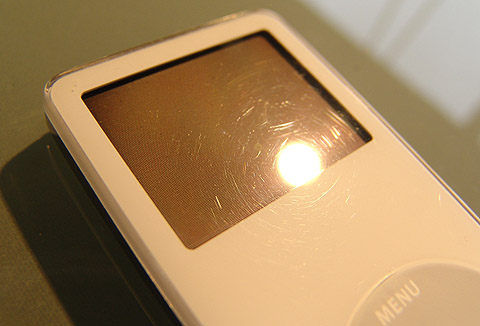
So, overall, it really is a beautifully designed product; however, it’s not without its problems. First of all, the device scratches like you wouldn’t believe. I’m talking about both the metal and polycarbonate surfaces. While the scratches on the metal surface are annoying, the scratches on the polycarbonate side are extremely unacceptable. Any scratches on the LCD screen area very noticeable and seem to be magnified by the way the screen is designed.

I know iPod owners will tell me, “If you’ve ever owned an iPod, you know you need to always need to keep it in a caseâ€. I actually keep the iPod nano in a soft-case that goes with another polycarbonate shell audio device that I have to keep it protected. However, the iPod nano manages to pickup scratches nonetheless. Even when cleaning the iPod nano with a microfiber cloth, the iPod nano can be scratched. That’s very disheartening and it seems that they’re using a lower grade of polycarbonate for the shell. You most definitely do not want to stick the iPod nano in your pocket even though Apple markets the device as being the iPod that fits into your “smallest pocketâ€. It’s hard for me to not be critical of the shell since I have another digital audio device with a polycarbonate/metal design (the Sony NW-E507) that barely has any scratches on it yet is abused daily in my pocket, at the gym, in my car and in my gear bag without having any protective case on it.
Connectivity
The iPod nano connection is straightforward. It uses a proprietary Dock connector-to-USB cable that’s standard among Apple iPod devices. This cable is used to transfer music and charge the device. You’ll definitely want to keep the cable handy just in case since you really won’t be able to do anything with your iPod if you lose this cable.
The iPod nano shows up in Windows XP as a USB Mass Storage Device so you don’t need any drivers to recognize the device. You will need iTunes 5.0 or higher to see the device in iTunes and the device ships with a copy of that. Thanks to the USB 2.0 connection, the transfer times are fast. If you have the 4GB model you should have plenty of capacity especially when using the iPod nano as your everyday mp3 player. Any left over space can be used to transfer files, etc. from computer to computer.

The headphone jack is located next to the Dock connector and provides a typical headphone out jack. It’s amplified out and does not offer a line out. You’ll need the optional $29 Dock if you require line out.
Interface
In typical Apple fashion, the iPod nano is extremely easy to use and utilizes the latest iteration of the iPod interface. The idea is simple. You simple slide your finger around the click wheel in a clockwise or counterclockwise motion in order to scroll up and down through the interface. In addition to scrolling through the interface, it also acts as the volume control depending on where you are in the interface. The wheel is very responsive and may take some time for some to get used to it. I found myself sliding past menu selections that I wanted the first couple of days until I got used to the sensitivity.
In the center of the scroll wheel is the “selection†button which you use to make selections or any other actions within the interface. The buttons around the side of the click wheel offer Menu on the top, Play/Pause on the bottom, and Skip Forward/Backward on the left and right sides of the wheel. It’s intuitive and well thought out.
If you use playlists then it’s really easy to get to your music as you can access playlists directly from the main menu. If you wish, you can dig down into your library and search for music by Genre, Artist, Album, All Songs, Composer and Playlists. As you drill down through any of the categories, you are further presented with logical subcategories. For instance, if you select Artist, you are then presented with a list of Artists. Drilling down further shows you all the Albums for that Artist so it works very logically allowing you to get to the song that you want.
You can also go through the interface while a song is playing without interrupting the playback until you find the next song that you want to hear.
Overall, the interface is excellent and no-nonsense. The only thing I noticed during my usage is that I found myself needing to look at the interface whenever I wanted to make major changes to what I was listening. Since I use my portable digital audio players when I’m doing some other activity (like driving) it’s nice to be able to control the interface with minimal interaction. With time, I’ve been able to memorize the interface enough to do some things based on getting to the main menu so it’s not a big deal.
Early on, my unit froze up hard several times requiring a hard reset of the unit multiple times before it would be recognized by my computers or iTunes. This made me kind of worried because I didn’t do anything out of the ordinary when using the unit. It hasn’t done it recently so perhaps it was a few isolated incidents but it left me a little worried. Otherwise it’s been trouble free and works as advertised.
Transferring Music
With the tight integration with Apple iTunes, transferring music to the iPod nano is very straightforward. As most people know, it’s really the standard by which other digital audio players and transfer software are judged and rightfully so.
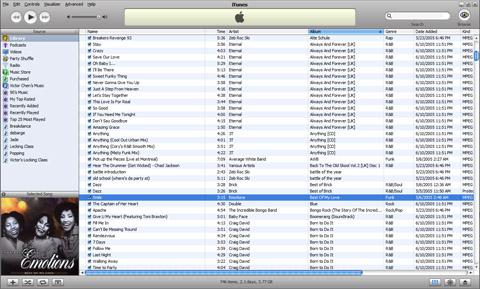
The iTunes interface is streamlined and you can sort your albums by a large number of categories and finding songs is a breeze by simply typing partial or full text into the search box. Obviously, the integration with the iTunes Music Store is huge if you want to purchase AAC formatted songs directly.
Once plugged into the system, the iPod nano automatically shows up in iTunes showing you your playlists and the songs that are loaded onto the system. You can have iTunes automatically copy songs over or you can manually manage the process.
Once songs are copied over you can create new playlists directly and drag songs over or simply rearrange your playlists accordingly. It all makes sense and is thoughtfully laid out.
Music isn’t the only thing you can synchronize with the iPod nano. You can also transfer photos, contacts and calendars over to the device. One of the big draws for me was the alleged synchronization with Outlook which was a nice feature to have. Unfortunately, the implementation is poorly executed. Contacts transfer over fine, but any contact that has more than one e-mail address (basically a large majority of my contacts) is duplicated in the list. This creates a very long list of contacts with multiple entries which is very annoying. The Calendar won’t sync at all and this isn’t an isolated issue. I’ve tried it on three separate systems to rule out the computer and it refuses to sync. The Apple forums are full of people who can’t sync either and Apple has yet to offer any help or fixes even in the latest iTunes 6.0. I’m sure it’s perfectly fine on the Mac platform but Windows users shouldn’t buy the product expecting these features to work as well.
Sound Quality
Sound quality is a pretty subjective area and varies from person to person. In my opinion, the sound quality of the iPod nano is very good. On default settings, the highs are very clean, the mid range sounds full, and the bass is decent although not as deep as I would like. I tested the iPod nano with the same headphones I use with all my devices which are a pair of Sony MDR-EX70SL earphones. The included Apple headphones are decent but they’re a little too big for my ears and cause discomfort if worn for too long.
The iPod nano’s volume also goes up very high so I don’t think anyone will complain that it’s not loud enough. The only problem that I see is that at the extreme end, the sound gets a little distorted.
If you’re unhappy with the default sound, you can go to the EQ settings in the menu to pick from one of the pre-configured sound modes.
The iPod nano (or any iPod for that matter) doesn’t support gapless playback which could be an annoyance to audio purists who like listening to concert soundtracks or gapless mixes that can be found on many CDs. Personally, I prefer gapless playback but it’s not a deal breaker.
Battery Life
While Apple claims 14 hours of battery life which is a little lower than I’m used to on a portable digital audio device. I was expecting the battery life to be better especially since it was a flash based device. On a full charge, I was able to coax a little over 13 hours of play time from the iPod nano before the battery was exhausted. I had the unit on shuffle repeat mode and only occasionally nudged the click wheel to check on the status of the battery. This means that the LCD was off for most of the time. So, Apple’s claims are pretty honest and you can expect close to what they say.
Constantly accessing the menus or setting the LED backlight to be on longer than default will obviously lower battery life. Still, the battery life should suffice for at least a day of usage. In my estimation, one needs to charge the device at least every 2-3 days with occasional usage to keep it from fully discharging. Under heavy usage, you’re likely going to want to charge it whenever you can since it drains pretty fast.
The battery indicator is fairly accurate although it seems that it drops much faster early on giving you the impression that the device drains battery really fast. However, the remaining 2-3 bars (if you’re counting the pixels) on the battery last a lot longer than you think.
Charging takes around 3 hours from a completely drained battery. Supposedly, it will charge up to 80% within 1.5 hours and then trickle charge the rest of the way. In most cases, people will want to keep it charged whenever they can.
Final Thoughts
The iPod nano is a beautifully designed portable digital audio player with great sound and great features. The battery life is as advertised and the color screen makes for an easy-to-use device. The integration with iTunes rounds out the end-to-end experience with a lot of polish and is the standard by which all competition is judged. Also, at $249, it’s priced very competitively compared to similar devices. However, while the design is excellent, the execution of the design is far from perfect. The build quality is marred by the fact that the polycarbonate front is susceptible to an unreasonable amount of scratching despite the best care.
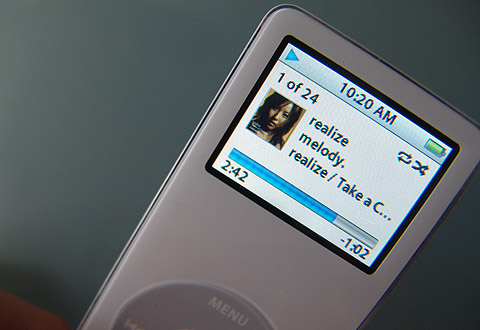
People will argue that you should “know†to buy a protective cover that covers the entire unit in order to keep from scratching the unit. However, Apple itself sells accessories like the iPod nano Armband that doesn’t even protect the unit from scratches. The LCD screen area is exposed and open to being scratched.
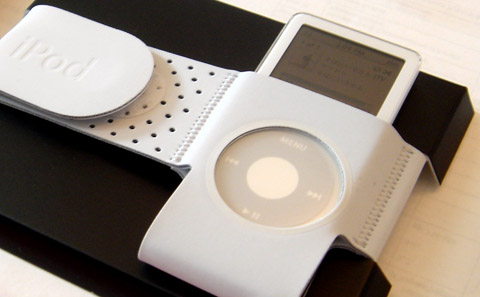
As a device that was meant for portable use and marketed as such, it should be reasonably resistant to scratching. Apple markets it by saying “its ultra-portable design fits into even the smallest pocket making it easy to take iPod nano to the gym, in the car, traveling, commuting or anywhere you go.†Even Steve Jobs was seen simply pulling it out of his pocket. However, no iPod nano owner in their right mind would dare stick a naked iPod nano in their pocket for fear of scratching the unit. It only makes sense that the body should be more durable especially because of the market it serves and the obvious usage it would encounter. Overall, it shouldn’t really deter a person from getting an iPod nano; however, you will definitely want to budget $20-50 more for protective casing in you want your iPod nano to remain in pristine shape. I recommend the The Invisible Shield ($20) in addition to whatever case/armband you end up getting for the device.
For more information about the iPod nano, visit the Apple iPod nano site.
If you’re interested in purchasing the iPod nano you can buy it here and help out this site at the same time!


